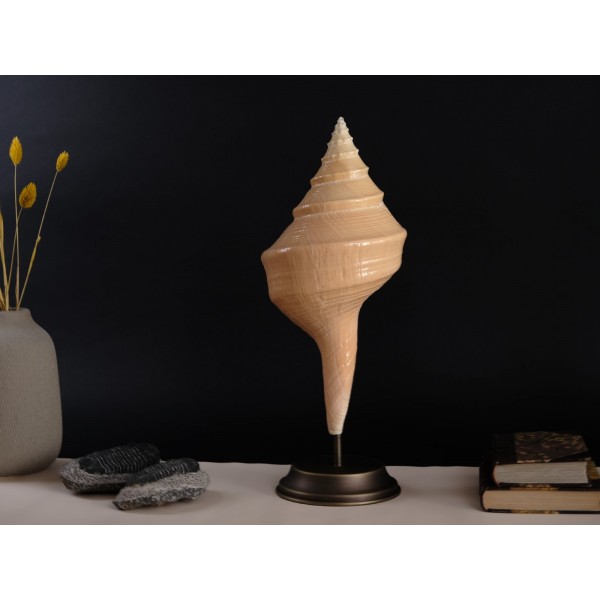Festilyria festiva
Festilyria festiva from Somalia. A classic rarity, for the serious collector of for decoration as its a very colorful shell, mounted in a black lacquered wood base.
| close |
This shop uses cookies to improve your experience on our website. |
Reference: N841
Syrinx aruanius - Australian Trumpet shell in a dark brass base.
It's a species of extremely large sea snail measuring up to 91 cm long and weighing up to 18 kg. Shells over 50 cm are now impossible to obtain, specially in good condition. It is a marine gastropod mollusk in the family Turbinellidae, and is the only species in the genus Syrinx.
Dimensions: 45 cm x 18 cm // Base: 15 cm diameter
Weight: 1,5 Kg

Syrinx aruanius - Australian Trumpet shell in a dark brass base.
It's a species of extremely large sea snail measuring up to 91 cm long and weighing up to 18 kg. Shells over 50 cm are now impossible to obtain, specially in good condition. It is a marine gastropod mollusk in the family Turbinellidae, and is the only species in the genus Syrinx.
Festilyria festiva from Somalia. A classic rarity, for the serious collector of for decoration as its a very colorful shell, mounted in a black lacquered wood base.
An exceptional specimen of pinna nobilis, from Greece, in a black lacquered wood frame .
The specimen came from a old collection, today is impossible to get this size specimen.
One of a Kind decor piece!
The two valves of a giant Acesta philippinarum, very rare, perfect condition in a pair of black lacquered wood pedestals.
These came from deep water, in tangle nets - from Balicasag island, Philippines.
Turbo marmoratus, from Indonesia, mounted in a handmade work in brass.
Known as the Green Turban, the Marbled Turban or Great Green Turban, is a large species of marine gastropod with a thick calcareous operculum in the family Turbinidae, the turban snails. The shells of these large sea snails have a very thick layer of nacre; this species has been commercially fished as a source of mother of pearl.
One of a Kind decor piece!
Beautiful Hexaplex nigritus from Mexico, always a very elusive shell, make a curious decor item.
Mounted in a brass and white lacquered wood base.
A spectacular Spondylus variegatus attached in a Malleus malleus shell from Davao - Philippines, in a black lacquered wood pedestal.
This is a uncommon attachment that came out by divers from time to time.
The two shells live in perfect symbiosis.
Tridacna gigas (Linnaeus, 1758)
Beautiful and very perfect resin replica in big size of this elusive piece protected nowadays.
It can be used as a decor piece, ice bucket or just for display!
A beautiful glass dome with 7 Epitonium scalare and a few small corals.
Epitonium scalare is a classic elusive species, from Philippines.
Giant Barrel Sponge (Xestospongia testudinaria) is a giant species of sponge found in the Indo-Pacific coral reefs. It commonly occurs at depths ranging from over 10 meters to 120 meters and can grow up to a diameter of 1.8 meters. The sponge typically exhibits a brownish-red to brownish-gray coloration, with a hard or stony texture. Due to its impressive size and estimated lifespan of hundreds to possibly thousands of years, the giant barrel sponge has earned the nickname "redwood of the reef." It displays a variable form, often appearing as a large, firm, barrel-shaped structure with a cone-shaped cavity at the top called the osculum. These sponges make beautiful decorative pieces. The specimen in question originates from Luzon, Philippines.
An exceptional specimen of pinna nobilis, from Greece, in a handmade brass base.
The specimen came from a old collection, today is impossible to get this size specimen.
One of a Kind decor piece!
Maoricardium pseudolima (commonly known as the Giant African Cockle) – This highly sought-after and edible mollusk is now overfished, with large specimens becoming increasingly rare. This particular piece comes from a batch collected over 30 years ago in the coastal waters north of Mombasa, Kenya.
The Giant African Cockle, with its large size and vibrant coloring, thrives buried in coral sand bottoms in the western Indian Ocean. In addition to its striking appearance, the meat of this mollusk is known for making a substantial and flavorful meal.
A colorful marine glass dome displaying an Acropora humilis coral, two Sugar Sea stars, two Alphonso Sea urchins, one purple sea urchin, two white knobbed urchins and two Mithrodia clavigera.
Beautiful decor piece for sea lovers!
Sponge species from Madagascar reefs, mounted in a black lacquered wood base.
Sponges are beautiful decor items, due to its different shapes and colours.
Table tray made with four Haliotis rufescens, mounted shamrock-shaped in a handmade brass base with Victorian look.
A unique piece to use in a luxury table ideal for dried fruit or chocolate and sweets.
The Haliotis came from California coast - USA.
Megabalanus from the Philippines is a type of barnacle, a marine crustacean belonging to the Balanidae family. What sets this Megabalanus apart is its larger and more robust size compared to other barnacle species. In terms of appearance, Megabalanus barnacles typically feature a conical or pyramid-shaped shell structure composed of overlapping plates or ribbed plates. These barnacles can be found in various marine environments, including rocky shores, coastal areas, and coral reefs.
Lambis chiragra - Spider shells, from Palawan Isl. Philippines, in dark brass base.
It's a species of very large sea snail, a marine gastropod mollusk in the family Strombidae, the true conchs. The shell length for this species varies between 85 mm and 320 mm, usually to 170 mm. They have a very thick, robust and heavy shell, with a distinct anterior notch.
Its most prominent characteristic are the six long and curved marginal digitations, expanded from the flaring, thick outer lip and canals. The columella and aperture are lyrate. Female individuals are usually much larger than the male ones.